Physical Address
304 North Cardinal St.
Dorchester Center, MA 02124
Since the first edition of this textbook, vascular radiology has changed beyond recognition. It was only 30 years ago that the role of radiology in the vascular system was mainly to provide diagnostic images using invasive angiography. Since the development of interventional techniques in the late 1980s, interventional radiologists have assumed a major role not only in the diagnosis of vascular disorders but also in their treatment. In the last decade an endovascular-first approach for the treatment of peripheral vascular arterial disease has gained widespread acceptance among specialists.
The other main advance in vascular radiology has been the development of non-invasive imaging such as duplex ultrasound, multidetector computed tomographic angiography (MDCTA) and magnetic resonance angiography (MRA). The current range of diagnostic and interventional techniques is too extensive to be described fully in a general textbook of radiology. The aim of this chapter is to provide a brief overview of salient features of diagnostic angiography and to describe the role of the main interventional techniques in the vascular system. Non-invasive angiographic imaging is described in Chapter 84 and a discussion of aortic and renal arterial disease is provided in Chapters 85 and 90.
The following are brief descriptions of the main therapeutic procedures used by vascular interventional radiologists.
Percutaneous transluminal angioplasty (PTA) refers to treatment of a vascular stenosis or occlusion with a balloon catheter, which is introduced into the blood vessel and advanced to the site of the lesion. The balloon is inflated for a short time. After the balloon is deflated, a check angiogram is performed to assess the success of the procedure ( Fig. 80.1 ). Angioplasty balloons may be drug-eluting or standard.
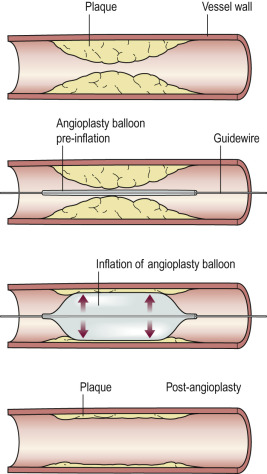
This refers to the placement of a metallic mesh tube across a vascular lesion such as a stenosis or occlusion. There are two main types of stent: balloon-expandable stents are mounted on a balloon catheter and deployed by inflating the balloon; self-expanding stents are compressed on a delivery catheter and released by withdrawing an outer sheath, allowing them to expand by their own radial force ( Fig. 80.2 ). Stents can be further divided into covered and uncovered types and drug-eluting versus bare metal types.
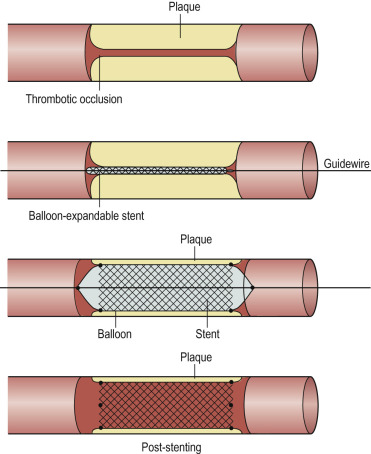
Stents may be used as the primary method of treatment or may be reserved for use if PTA is unsuccessful, depending on the location and type of lesion. Covered stents are typically used to exclude an aneurysm or bleeding point from the main circulation ( Fig. 80.3 ).
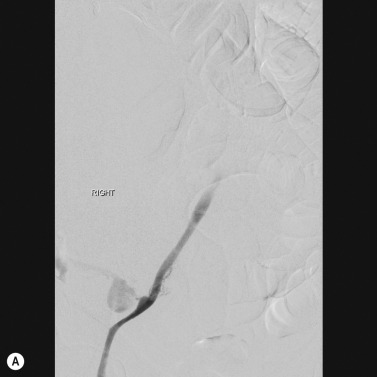
Embolisation refers to the occlusion of a blood vessel by the delivery of embolic material through a catheter. Embolisation has a wide range of applications, including the treatment of haemorrhage, aneurysms, vascular malformations, benign conditions such as uterine leiomyomata and prostatic hypertrophy, and the treatment and palliation of cancer, particularly primary and secondary hepatic malignancy.
There are a large variety of embolic agents, including metallic springs (coils), plugs (nitinol basket-type devices), particulate matter, gelatin sponges, glue and liquid agents. The choice depends on the anatomical site, the nature of the lesion and the personal preference of the operator.
Some embolic agents, such as gelatin sponges, are considered temporary and can be used to control haemorrhage when, once the ‘acute’ lesion has healed, recanalisation of the parent vessel may be desirable—for example, traumatic injury to the internal iliac artery following pelvic trauma. Permanent particulate emboli are made from various agents, but polyvinyl alcohol (PVA) is the best-known example. These agents are not radio-opaque and must be suspended in contrast medium. They cause occlusion by ‘silting up’ the blood supply. The level of occlusion depends on the size and type of particles chosen. Particulate emboli are used in the treatment of benign and malignant tumours, such as uterine leiomyoma and renal angiomyolipoma ( Fig. 80.4 ). Particles may be used in combination with chemotherapeutic agents (drug-eluting beads or particles loaded with a chemotherapeutic agent) in hepatic chemoembolisation. Coils are used in situations analogous to the surgical ligation of a vessel ( Fig. 80.5 ), but knowledge of vascular anatomy is essential to avoid retrograde filling of a lesion from collateral vessels. Coils are used widely in the embolisation of haemorrhage ( Fig. 80.6 ) and the exclusion of aneurysms and pseudoaneurysms.
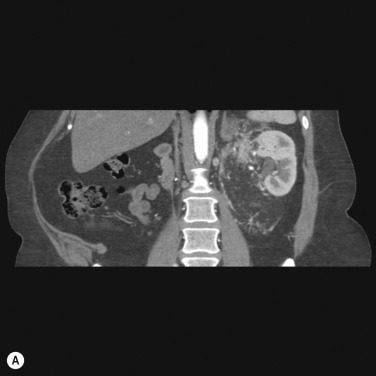
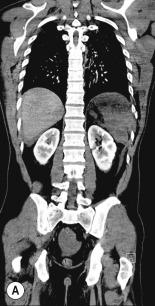
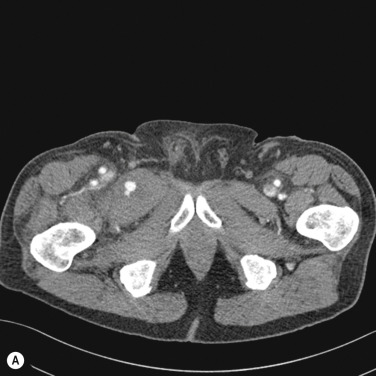
Liquid embolic agents include sclerosants such as absolute alcohol, sodium tetradecyl sulphate (STD), glue (e.g. n-butyl-2-cyanoacylate) and newer agents such as Onyx, a liquid embolic agent. Sclerosants are useful in venous embolisation (e.g. pelvic congestion syndrome). and low-flow vascular malformations. Glue and Onyx are particularly useful in dealing with high-flow arteriovenous malformations and visceral artery aneurysms (VAAs).
This refers to the dissolution of blood clots within an artery or vein by the injection or infusion of a thrombolytic (clot-dissolving) drug directly into the thrombus through a catheter which has been advanced directly into the thrombus. Although successful thrombolysis may be achieved within a short time, it is not uncommon for the lytic agent to be infused over 24–48 hours. Patients undergo periodic check angiography to assess the progress of the treatment. In most cases, successful clearance of the thrombus reveals an underlying causative lesion, which should be treated by angioplasty or stenting during the same procedure. Thrombolysis was a very popular technique for the treatment of acute lower limb ischaemia about 15 to 25 years ago. It is less often used now, given the associated risk of haemorrhage, but is still performed in selected cases.
At the level of L4, the aorta divides into the common iliac arteries, which pass in front of the iliac veins and give off no major branches. At the level of the mid-sacrum, they divide into the external and internal iliac arteries. The internal iliac arteries supply the pelvis and surrounding musculature. They divide into anterior divisions, which supply the viscera, and posterior divisions, which mainly supply the musculature. The external iliac artery has no major branches, although it gives rise to the inferior epigastric artery at the junction with the common femoral artery. At the level of the inguinal ligament, the external iliac artery becomes the common femoral artery—a short vessel that gives rise to the profunda femoris (or deep femoral artery), which supplies the muscles of the thigh, and the superficial femoral artery (SFA), which has no major branches and passes distally. At the level of the adductor canal, the SFA becomes the popliteal artery, which gives rise to the vessels of the calf, which are the anterior and posterior tibial arteries and the peroneal artery. At the level of the ankle, the anterior tibial artery becomes the dorsalis pedis artery and the posterior tibial artery divides into the medial and lateral plantar arteries. The anterior tibial artery is the most lateral calf vessel, whereas the posterior tibial artery is the most medial. In the forefoot, the plantar arch is formed by the lateral plantar branch of the posterior tibial artery and the dorsalis pedis artery ( Fig. 80.7 ). Anatomical variations of the lower extremity arteries are outside the scope of this chapter.
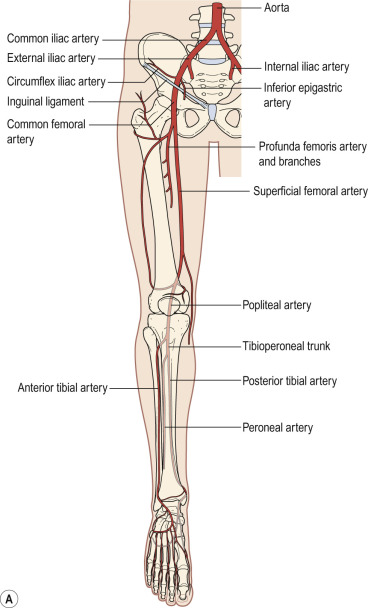
The most common condition affecting the arteries of the lower extremity is tissue ischaemia due to stenotic or occlusive disease. Occlusive disease may be acute, acute-on-chronic (where acute occlusion occurs in the presence of a previous chronic stenosis or occlusion) or chronic occlusion. Most patients present with symptoms of chronic occlusive disease, usually caused by atherosclerosis. Less common causes include thromboembolism, acute thrombotic occlusion, microembolism, entrapment syndromes, cystic adventitial disease, trauma and vasculitis, including vasospastic disorders and Buerger disease.
The clinical presentation varies depending on the type, location and number of the arterial lesions. Patients may be asymptomatic, may suffer from pain on walking (intermittent claudication), may experience pain at rest or may have tissue loss in the form of either ulceration or gangrene. In general, patients with intermittent claudication are not treated with invasive procedures unless their claudication distance is very short, they have failed a trial of supervised exercise therapy or their symptoms substantially limit their lifestyle. Patients with critical limb ischaemia, including rest pain and tissue loss, are at risk of limb loss and must be treated by angioplasty, stenting or surgery.
Most pathological processes affecting the arteries of the lower extremity cause stenosis, occlusion or dilation—i.e. aneurysm formation. Atherosclerosis may affect the arteries at any level, from the iliac arteries to the small vessels of the foot. Although it is true that a stenosis or occlusion is almost always due to atherosclerosis, it is important to consider other possible causes. The clinical history may often be of help in this respect. For example, a patient who develops acute severe pain in the lower leg with no previous history or symptoms probably has a recently sustained acute embolus in the femoral or popliteal arteries rather than a long-standing atherosclerotic occlusion. Patients with diabetes develop arterial occlusive disease, which involves mainly the distal vessels of the calf and feet. Patients with a history of radiotherapy to the pelvis for the treatment of carcinoma of the cervix may develop occlusive lesions of the common and external iliac arteries due to ischaemic vasculitis induced by the radiation.
In the treatment of stenotic lesions, PTA has a technical success rate approximating 100% ( Fig. 80.8 ). Stents are used when PTA is immediately unsuccessful, with ulcerated lesions or when lesions recur soon after a previous angioplasty. There is no evidence that primary stenting is better than a policy of angioplasty with selective stenting for PTA failure. Five-year patency rates are around 64%–75%, which, although lower than those of surgical aortobifemoral bypass, are acceptable considering the minimally invasive nature of this treatment.
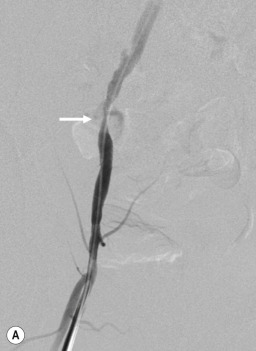
Patients with diffusely stenosed iliac arteries respond less well to PTA. These patients are often treated with stents, although there is no definite evidence to support this policy.
Occlusions of the iliac artery are usually amenable to endovascular treatment, with a technical success rate of recanalisation of around 80% ( Fig. 80.9 ). Most operators favour primary stent insertion because angioplasty carries a 7%–24% risk of significant distal embolisation. The durability of endovascular treatment of iliac artery occlusion is similar to that for iliac artery stenosis. There is some evidence that covered stents for iliac bifurcation occlusions yield more long-term patency than uncovered stents.
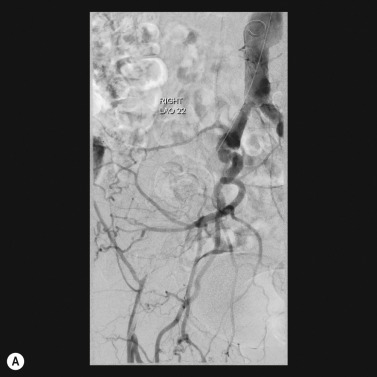
Become a Clinical Tree membership for Full access and enjoy Unlimited articles
If you are a member. Log in here